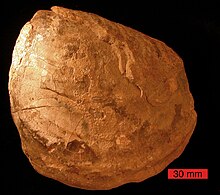|
Inoceramidae
The Inoceramidae are an extinct family of bivalves ("clams") in the Class Mollusca. Fossils of inoceramids are found in marine sediments of Permian to latest Cretaceous in age. Inoceramids tended to live in upper bathyal and neritic environments.[1] Many species of inoceramid are found all over the world, demonstrating the wide distribution of their preferred ecosystems, and possibly long-lived planktotrophic larvae.[2] Despite their wide distribution, the pace of evolution of inoceramids was great, with species ranges commonly averaging 0.2-0.5 Ma.[2] Size Various species of inoceramids have achieved shell sizes ranging from small to large. Members of the Inoceramus and Cladoceramus genera have shells of more than 1 metre (3 ft 3 in) in length.[2] In 1952, a huge specimen of Inoceramus steenstrupi 1.87 metres (6 ft 2 in) long, was found in Qilakitsoq, the Nuussuaq Peninsula, Greenland. This fossil is 83 Ma old, the Upper Santonian or Lower Campanian stage.[3] TaxonomyInoceramidae Giebel, 1852
Footnotes
Further reading |
||||||||||||||||||||||
Portal di Ensiklopedia Dunia
